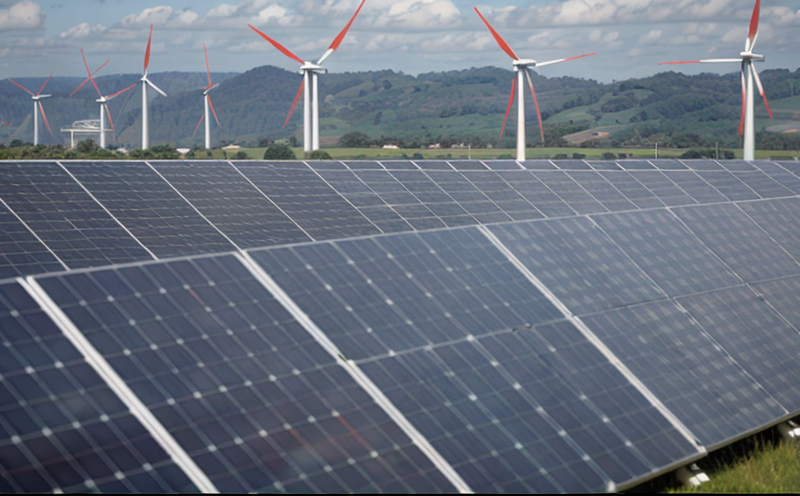Extractives Content Testing
The extraction of natural products from agricultural and forestry resources is a crucial process in renewable energy systems. Extractives content testing plays an essential role in ensuring that these materials are of high quality, consistent with industry standards, and suitable for various applications within the renewable energy sector.
Extractives are organic compounds found in plant materials such as wood, lignin, and cellulose. They can be extracted using solvents like methanol or ethanol under controlled conditions. The content of these extracts is critical because they influence the properties of biofuels, bioplastics, and other renewable energy products derived from agricultural and forestry resources.
The testing process begins with sample preparation where raw materials are ground into a fine powder to ensure uniformity. This step ensures that the subsequent extraction process yields accurate results. The extractive content is then determined using gravimetric methods or spectrophotometric techniques, depending on the specific requirements of the application.
Compliance with international standards such as ISO 17659 for lignin and cellulose in wood pulp is essential to ensure that the testing process meets industry expectations. The use of these standards ensures consistency and comparability across different laboratories worldwide.
The importance of extractives content testing cannot be overstated, especially given the increasing demand for sustainable energy solutions. By accurately measuring the extractive content, manufacturers can optimize their processes, reduce waste, and produce higher quality products that meet stringent regulatory requirements.
One real-world example is the production of lignin-based adhesives in forestry applications. Accurate extraction and measurement of lignin content are critical to ensuring that these adhesives have the right properties for use in furniture manufacturing or building construction. Similarly, in biofuel production, understanding extractive content helps ensure efficient conversion processes and higher yields.
Another application is in the development of bioplastics from agricultural by-products. By measuring the extractive content during the early stages of product development, researchers can refine their formulations to meet performance criteria. This not only enhances sustainability but also contributes to reducing reliance on petroleum-based plastics.
- Gravimetric analysis for precise extraction measurement.
- Spectrophotometric techniques for rapid and accurate results.
The test process involves multiple steps, including sample preparation, extraction, drying, weighing, and calculation of extractive content. Each step requires meticulous attention to detail to ensure accuracy and reliability.
By leveraging advanced analytical technologies, laboratories can provide clients with detailed reports that not only quantify the extractive content but also offer insights into potential improvements in production processes or formulation adjustments.
Benefits
Extractives content testing offers numerous benefits to stakeholders within the agriculture and forestry sectors. For quality managers, it provides a critical tool for ensuring product consistency and compliance with industry standards. This helps maintain customer satisfaction and fosters trust in brand reputation.
Compliance officers benefit from extractives content testing by having robust data to demonstrate adherence to regulatory requirements. This supports effective management of risks associated with non-compliance penalties or market withdrawals.
R&D engineers can use the results of these tests to innovate and develop new products that meet evolving market needs. The insights gained from understanding extractive content allow them to explore novel applications and improve existing ones.
For procurement teams, accurate extraction testing ensures that raw materials purchased are suitable for specific uses. This reduces the risk of substandard inputs leading to defective outputs or wasted resources.
- Enhanced product quality through consistent measurement of extractive content.
- Improved process efficiency by identifying areas for optimization based on extracted data.
The ability to predict and adjust production parameters ensures that final products align perfectly with customer specifications, thereby enhancing overall competitiveness in the market.
Why Choose This Test
- Precision: The gravimetric method provides highly accurate measurements of extractive content.
- Efficiency: Spectrophotometric techniques offer quick results without compromising accuracy.
- Regulatory Compliance: Adherence to international standards ensures consistency across all tests.
- Innovation Support: Insights from testing facilitate advancements in product development and formulation.
The decision to perform extractives content testing is driven by the need for precise measurement of organic compounds extracted from agricultural and forestry resources. This precision is vital for maintaining high-quality standards, ensuring compliance with regulations, supporting innovation, and enhancing overall competitiveness within the renewable energy sector.
By choosing this test, stakeholders gain confidence in their products' reliability and performance while contributing to sustainable practices that benefit both current and future generations.
Environmental and Sustainability Contributions
The extraction of natural compounds from agricultural and forestry resources plays a vital role in promoting environmental sustainability. By accurately measuring extractives content, laboratories contribute significantly to the development of renewable energy solutions that are not only efficient but also environmentally friendly.
Incorporating sustainable practices into testing methodologies helps reduce waste generation and promotes resource efficiency throughout the supply chain. For instance, optimizing extraction processes based on extracted data can lead to reduced solvent usage and minimized greenhouse gas emissions during production.
Moreover, by ensuring that raw materials used in renewable energy products are of high quality, laboratories contribute to minimizing environmental impacts associated with substandard inputs. This includes reducing water pollution from poor-quality biofuels or bioplastics that do not meet specified standards.
The use of extractives content testing also supports lifecycle assessment (LCA) studies by providing valuable information on material composition and potential impacts at various stages of product development and usage. This data helps manufacturers make informed decisions about sustainable practices throughout their operations, from sourcing raw materials to end-of-life disposal strategies.
- Promotion of resource efficiency through optimized extraction processes.
- Reduction in waste generation by minimizing unnecessary inputs into production cycles.
Ultimately, the environmental and sustainability contributions made by extractives content testing are far-reaching, impacting not only immediate operational practices but also broader industry trends towards greener technologies and more sustainable business models.





